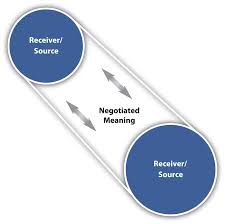Two Models of Communication
Researchers have observed that when communication occurs, the source and the receiver may send messages simultaneously, often overlapping. As the speaker, you will often play both roles, as source and receiver. You’ll focus on the communication and the reception of your messages to the audience. The audience will respond with feedback that will give you important
clues. While there are many communication models, here we will focus on two that offer perspectives and lessons for business communicators.
Rather than looking at the source sending a message and someone receiving it as two distinct acts, researchers often view communication as a transactional process (Figure 1.2.2), with actions often happening simultaneously. The distinction between source and receiver is blurred in conversational turn-taking, for example, where both participants play both roles simultaneously.

Figure 1.2.2: Transactional Model of Communication
Researchers have also examined the idea that we all construct our own interpretations of the message. As defined at the beginning of this chapter, what is said and what is heard may be different. In the constructivist model (Figure 1.2.3), we focus on the negotiated meaning, or common ground when trying to describe communication (Pearce & Cronen, 1980).

Figure 1.2.3: Constructivist Model of Communication
For example: Imagine that you are visiting Atlanta, Georgia, and going to a restaurant for dinner. When asked if you want a “Coke,” you may reply, “Sure.” The waiter may then ask you again, “What kind?” and you may reply, “Coke is fine.” The waiter then may ask a third time,
“What kind of soft drink would you like?” The misunderstanding in this example is that in Atlanta, the home of the Coca-Cola Company, most soft drinks are generically referred to as “Coke.” When you order a soft drink, you need to specify what type, even if you wish to order a beverage that is not a cola or not even made by the Coca-Cola Company. To someone from other regions of the United States, the words “pop,” “soda pop,” or “soda” may be the familiar way to refer to a soft drink; not necessarily the brand “Coke.” In this example, both you and the waiter understand the word “Coke,” but you each understand it to mean something different.
In other words, in order to communicate, you must each realize what the term means to the other person, and establish common ground in order to fully understand the request and provide an answer. Because we carry the multiple meanings of words, gestures, and ideas within us, we can use a dictionary to guide us, but we will still need to negotiate meaning.
Key Takeaway
The communication process involves understanding, sharing, and meaning, and it consists of eight essential elements: source, message, channel, receiver, feedback, environment, context, and interference. Among the models of communication are the transactional process, in which actions happen simultaneously, and the constructivist model, which focuses on shared meaning.
Exercises
Draw what you think communication looks like. Share your drawing with your classmates.
List three environmental cues and indicate how they influence your expectations for communication. Please share your results with your classmates.
How does context influence your communication? Consider the language and culture people grew up with, and the role these play in communication styles.
If you could design the perfect date, what activities, places, and/or environmental cues would you include to set the mood? Please share your results with your classmates.
Pearce, W. B., & Cronen, V. (1980). Communication, action, and meaning: The creating of social realities. New York, NY:
Praeger.
This page titled 1.2: What is Communication? – Two Models is shared under a CC BY-NC-SA 3.0 license and was authored, remixed, and/or curated by Anonymous (LibreTexts Staff), from which source content was edited to the style and standards of the Pressbook platform licensed under a Creative Commons Attribution-NonCommercial-ShareAlike 4.0 International License by Brandi Schur.

